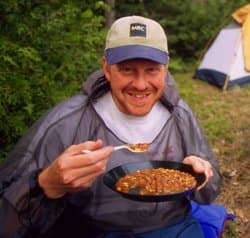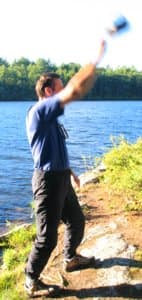Thinking Beyond Camp Gruel

If you're car camping, or the portages on your interior canoe trip happen to be short (or better yet, nonexistent), then you definitely have the privilege of taking along a few luxury food items. After all, some dehydrated meals taste a little like munching on a cardboard box. So there's nothing better than to be able to pack fresh meat and vegetables, at least for the first few days of your trip. There's absolutely nothing like it. Imagine ending your day and dinning on a juicy steak, crisp salad, and chocolate ice cream for dessert.
Here are a few tips on keeping the fresh food fresh and the frozen food frozen.
- Some meats, like bacon and sausage, will last longer than other meats due to the high amount of preservatives
- Vacuum-sealing meat and vegetables will greatly increase their pack life. Don't go out and buy a vacuum machine right away though. Most grocery stores will seal your purchase free of charge.
- Meat can be kept bacteria free for up to four days by wrapping it up in a piece of J-cloth or cheese-cloth that has been soaked (not saturated) in vinegar. The vinegar smell/taste disappears as soon as the meat is placed over the fire.
- Cheese can also stay fresh much longer by wrapping it up in a vinegar soaked J-cloth or cheese cloth and then dipped in paraffin wax.
- To keep frozen meat from thawing out too quick make sure to marinade it (liquid marinade acts as an ice pack), store it in a zip-lock plastic bag, and then wrap it in newsprint, or better yet, insulation material used for ironing boards.
- Frozen meat should be placed in the center of the food bag, which is always kept away from direct sunlight, or stored in a small cooler. The soft sided cooler bags don't necessarily work as well at keeping things as cool as plastic, but when empty they can easily be stuffed into your backpack for storage.
- Crushed ice you see at the grocery store holds the fish and other sea-food, is the best ice to pack in your cooler. It lasts longer than regular run-of-the-mill ice and the store will probably give it away for free.
- Dry ice works great to keep items completely frozen for up to six days. Also, as it melts it turns directly into carbon dioxide rather than a liquid, leaving no problems with freezer burn or wet food bags. It works well for meat, margarine, ice cubes and even ice cream. But it has a tendency to burst open pop or beer cans, weighs a fair bit (10 lbs.), and can be a real hassle to find if you don't live near a major city with a medical supply business.

- Never break eggs from the shell and then store them in a liquid container. This method is believed by some as a way to not worry about having their eggs broke in storage. Little do they know, however, that once the egg leaves the shell, it instantly becomes a breeding ground for bacteria, and is one sure way to get massive food poisoning on your trip. Also, always buy fresh eggs from the farmer's market rather from than the grocery store. They haven't been sitting around as long, making them last at least three times longer. And the best place to store them is in a Styrofoam carton, stuffed in the center of your pack or Duct taped firmly under the canoe seat.
- When making salads make sure to choose red cabbage or Japanese napa cabbage rather than the regular head of lettuce. They keep for weeks without refrigeration and make a tasty side dish when mixed with shredded carrots, red onion slices, red and green peppers, raisins and cashews.
- Vegetables such as tomatoes, peppers and celery will last much longer if you first float them in a sink of cold water and two tablespoons of chlorine bleach. Allow them to soak for a few minutes, air dry them, and then pack them away. The bleach will kill any surface bacteria that promote spoilage.
- The best way to chill your wine for the evening meal is to store it in a collapsible water bottle like a Platypus, and then troll it behind you on a long rope about a half hour before reaching camp.
True Grit Camp Coffee

True camp coffee is nothing but real grounds-and-water-in-the-pot coffee. Bring water to a rolling boil, take it off the heat source, dump in one generous Tbs. of coffee grounds per cup of water, and let it steep (covered) alongside the campfire for approximately five to ten minutes. To settle the grounds, tap a spoon on the side of the pot 3 to 5 times.
The most crucial element of brewing "true grit" is to never let the coffee boil once you've taken it off the heat source. Old-timers used to say that boiled coffee tastes like rotten shoe leather, and they're right! The reason for the bad taste of boiled coffee is in the bitter tanic acid and flavouring oils it contains. The tasty oils are released at 205° F (86° C), just below boiling point. The bitter acids, however, are released right at or just above boiling point.
Another important factor is how to settle the grounds before serving the coffee. Some people throw pieces of egg shell or toss in a few round pebbles. I've even witnessed campers take hold of the wire handle on the pot, swing it with the speed of an aircraft propeller, and have complete faith in centrifugal force. This suicidal action will pull the grounds to the bottom of the pot - guaranteed. I merely tap the side of the pot with a knife or spoon and then make sure to offer the first and last cup of coffee to someone else in the group.
Kevin Callan is the author of eight books including 'The Happy Camper: An Essential Guide to Life Outdoors'. He is a recipient of the National Magazine Award and a regularly featured speaker at North America's largest paddling events.
Related Articles
I've been busy lately rearranging my cooking essentials: the little tools that I can't do without. Of…
"All day I've faced a barren waste without the taste of water, cool water.Old Dan and I with throats…
Who says that cooking with herbs should be reserved only for home cooks and that campers shouldn't take…
Christmas is just around the corner and you are again left wondering what to offer your favorite…

